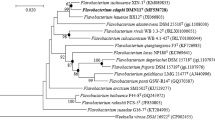Abstract
Strain YF-2T, a Gram-staining-negative, non-motile, non-spore-forming, light-yellow-pigmented bacterium, was isolated from soil samples collected in the city of Yuncheng, Shanxi province of China. Strain YF-2T grew over a temperature range of 25–37 °C, at pH 5.0–8.0 and with 0–5 % (w/v) NaCl. Phylogenetic analysis based on sequence of the 16S rRNA gene showed that strain YF-2T was closely related to strains Flavobacterium akiainvivens CIP 110358T and Flavobacterium hauense KCTC 32147T with 95.99 and 95.92 % sequence similarity, respectively. The dominant fatty acids of strain YF-2T were Summed Feature 3 (comprising C16:1 ω7c and/or C16:1 ω6c) (21.97 %), iso-C15:0 (18.65 %), iso-C17:0 3OH (11.41 %), C16:0 (9.92 %), and anteiso-C15:0 (6.21 %). It contained phosphatidylethanolamine and menaquinone MK-6 as major polar lipid and respiratory quinone, respectively. Strain YF-2T differs from other Flavobacterium species in many characteristics and represents a novel species, for which the name Flavobacterium shanxiense sp. nov. is proposed. The type strain is strain YF-2T (=CCTCC AB 2014079T = JCM 30153T).

Similar content being viewed by others
References
Bergey DH, Harrison FC, Breed RS, Hammer BW et al (1923) Genus II. Flavobacterium gen. nov. In: Bergey’s manual of determinative bacteriology. Williams & Wilkins, Baltimore, pp 97–117
Aihua L, Hongcan L et al (2014) Flavobacterium lacus sp. nov., isolated from a high-altitude lake, and emended description of Flavobacterium filum. Int J Syst Evol Microbiol 64:933–939
Jin HK, Bo HC, Minho J et al (2014) Flavobacterium faecale sp. nov., an agarase-producing species isolated from stools of Antarctic penguins. Int J Syst Evol Microbiol. doi:10.1099/ijs.0.059618-0
Daichi F, Fumiko N et al (2014) Flavobacterium longum sp. nov. and Flavobacterium urocaniciphilum sp. nov., isolated from a wastewater treatment plant, and emended descriptions of Flavobacterium caeni and Flavobacterium terrigena. Int J Syst Evol Microbiol 64:1488–1494
Zamora L, Vela AI et al (2014) Flavobacterium tructae sp. nov. and Flavobacterium piscis sp. nov., isolated from farmed rainbow trout (Oncorhynchus mykiss). Int J Syst Evol Microbiol. doi:10.1099/ijs.0.056341-0
Thomas PL, Mohamed F (2014) Flavobacterium spartansii sp. nov., a pathogen of fishes, and emended descriptions of Flavobacterium aquidurense and Flavobacterium araucananum. Int J Syst Evol Microbiol. doi:10.1099/ijs.0.051433-0
Gerhardt P, Murray RGE, Wood WA, Krieg NR (eds) (1994) Methods for general and molecular bacteriology. American Society for Microbiology, Washington
Smibert RM, Krieg NR (1994) Phenotypic characterization. In: Gerhardt P, Murray RGE, Wood WA, Krieg NR (eds) Methods for general and molecular bacteriology. American Society for Microbiology, Washington, pp 607–654
Tindall BJ, Sikorski J et al (2007) Phenotypic characterization and the principles of comparative systematics. In: Methods for General and Molecular Microbiology, 3rd edn. pp 330–393
Collins MD, Pirouz T, Goodfellow M, Minnikin DE (1977) Distribution of menaquinones in actinomycetes and corynebacteria. J Gen Microbiol 100:221–230
Tamaoka J, Katayama-Fujimura Y, Kuraishi H (1983) Analysis of bacterial menaquinone mixtures by high performance liquid chromatography. J Appl Bacteriol 54:31–36
Kämpfer P, Kroppenstedt RM (1996) Numerical analysis of fatty acid patterns of coryneform bacteria and related taxa. Can J Microbiol 42:989–1005
Sasser M (1990) Identification of bacteria by gas chromatography of cellular fatty acids. MIDI Technical Note 101. MIDI, Newark
Lane DJ (1991) 16S/23S rRNA sequencing. In: Stackebrandt E, Goodfellow M (eds) Nucleic acid techniques in bacterial systematics. Wiley, New York, pp 115–175
Kim OS, Cho YJ et al (2012) Introducing EzTaxon-e: a prokaryotic 16S rRNA gene sequence database with phylotypes that represent uncultured species. Int J Syst Evol Microbiol 62:716–721
Tamura K, Peterson D, Peterson N, Stecher G, Nei M, Kumar S (2011) MEGA5: molecular evolutionary genetics analysis using maximum likelihood, evolutionary distance, and maximum parsimony methods. Mol Biol Evol 28:2731–2739
Thompson JD, Gibson TJ et al (1997) The CLUSTAL_X windows interface: flexible strategies for multiple sequence alignment aided by quality analysis tools. Nucleic Acids Res 25:4876–4882
Kimura M (1980) A simple method for estimating evolutionary rates of base substitutions through comparative studies of nucleotide sequences. J Mol Evol 16:111–120
Saitou N, Nei M (1987) The neighbor-joining method a new method for reconstructing phylogenetic trees. Mol Biol Evol l4:406–425
Felsenstein J (1985) Confidence limits on phylogenies: an approachusing thebootstrap. Evolution 39:783–791
Sambrook J, Russell DW (2001) Molecular cloning: a laboratory manual. Cold Spring Harbor Laboratory Press, Cold Spring Harbor
Tamaoka J, Komagata K (1984) Determination of DNA base composition by reversed-phased high-performance liquid chromatography. FEMS Microbiol Lett 25:125–128
Bernardet JF, Segers P et al (1996) Cutting a Gordian knot: emended classification and description of the genus Flavobacterium, emended description of the family Flavobacteriaceae, and proposal of Flavobacterium hydatis nom. nov. Int J Syst Bacteriol 46:128–148
Van TS, Mergaert J, Swings J (2003) Flavobacterium gelidilacus sp. nov., isolated from microbial mats in Antarctic lakes. Int J Syst Evol Microbiol 53:1241–1245
Kun D, Biao X, Fengqiu Z, Gejiao W (2013) Flavobacterium hauense sp. nov., isolated from soil and emended descriptions of Flavobacterium subsaxonicum, Flavobacterium beibuense and Flavobacterium rivuli. Int J Syst Evol Microbiol 63:3237–3242
Acknowledgments
This work was supported by The National High Technology Research and Development Program of China (2012AA101403), Chinese National Natural Science Fund (31370155, J1210056) and The Project for Science and Technology of Jiangsu Province (BE2012749).
Author information
Authors and Affiliations
Corresponding author
Electronic supplementary material
Below is the link to the electronic supplementary material.
Rights and permissions
About this article
Cite this article
Yang, F., Liu, Hm., Zhang, R. et al. Flavobacterium shanxiense sp. nov., Isolated from Soil. Curr Microbiol 70, 835–839 (2015). https://doi.org/10.1007/s00284-015-0792-z
Received:
Accepted:
Published:
Issue Date:
DOI: https://doi.org/10.1007/s00284-015-0792-z




